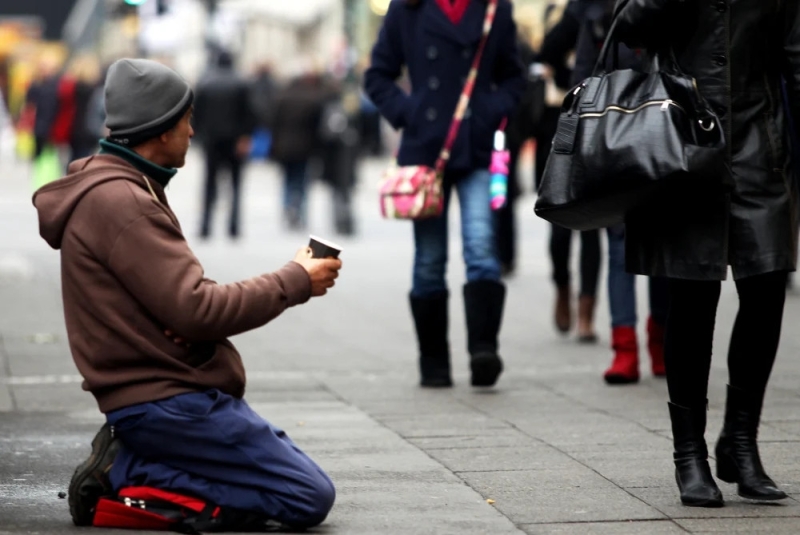Students in Germany on the poverty line
One in three students in Germany lives below the poverty line. State subsidies to cover the rising cost of food, gas and electricity are not enough for those struggling to get by.
For Melissa, cooking for herself is now a luxury. The 23-year-old psychology student prefers to stroll to the cafeteria at her university in Bonn. "You can get lunch there for €2 to €3 ($1.94 to $2.92)."
It's not that living frugally is new to Melissa. During her study years, the weekly shopping budget has been €25. But increased prices now make that impossible. "I'm already at €35 to €40 a week if I really buy food to cook at home."
"You really notice it in your wallet."
The student receives €750 a month in federal student grants (BAföG) and her parents pass along the €219 they receive as a child benefit. But of that nearly €1,000, some €400 alone goes toward rent for her 15-square-meter room in a shared apartment in Bonn.
"Food is the first thing I save on," she tells DW. "I just have potatoes, cottage cheese and vegetarian schnitzel."
When her university fees are due at the beginning of the semester, €300 is gone in one fell swoop.
Inflation and energy crisis hit the young
According to this year's poverty report, almost one in three students in Germany lives below the poverty line.
The situation could get worse with current inflation rates and the impending energy crisis, says Andreas Aust, a social worker from the German Parity Welfare Association.
"Parents will now also find it much more difficult to finance their children," he said. "Federal grants for students are not only too low, but above all the problem is that many fall through the cracks. Very few students receive these benefits at all."
In fact, only one in nine of the nearly 3 million students in Germany receives state support.
By definition, such support should enable anyone, regardless of their socioeconomic situation, to pursue an education.
Maximum allowance still below the poverty line
The German government has now imposed a 5.75% increase in basic support for students starting in the winter semester of 2022/23, as well as adjusting the income limit for parents.
From October 2022, the maximum allowance is €934 a month, provided students do not live in the same household as their parents.
But that doesn't solve the problem, Aust says, because the current 10% rate of inflation "simply swallows up" this increase.
Rahel Schüssler of the Free Association of Students, which represents nearly one-third of all those studying in Germany, also believes that the increase is not enough. "The student allowance maximum rate is still below the poverty threshold in Germany," she says.
In Germany, a person is considered at risk of poverty if they live on less than €1,251 per month.
Energy subsidies a drop in the ocean
Due to the increased cost of living, it is now not uncommon for students to take on up to two part-time jobs to finance their studies.
"You actually only work in order to be able to study. Because of work, however, you don't get to study anymore," Schüssler says.
There are no official statistics on how many students have dropped out of their studies in the last two years, but Schüssler has heard from many students that financial problems have played a decisive role.
"Students also decide to drop out because of rising prices. To maybe not just look for a part-time job, but then rather to just work 40 hours a week from the get-go."
Experts also see the €200 flat-rate energy allowance — to be paid out by the federal government as a one-time bonus to students — as no more than a "symbolic gesture."
Aust also points out that it is still "completely unclear how the money is actually supposed to reach students."
Fewer new enrollments
One in two students receives financial support from their parents, according to a study by the German National Association for Student Affairs.
For Aust, it is clear that rising food and energy prices will also have an impact on educational opportunities in Germany in the medium term.
"Those who are short of money will think twice or even three times before sending their children to study. Or whether they would rather choose a more traditional path and earn a living instead of investing further in education," he says.
According to the Federal Statistical Office, the number of first-year students continued to decline in 2021. There are demographic reasons for the drop in new enrollments, but it is also in part due to the COVID-19 pandemic — why study when you're just sitting at home anyway?
More university closures considered
Universities were the first public places to close their doors when the pandemic began in the spring of 2020. And the last to reopen them.
again be forced to study from home — but this time due to increased energy prices.

Comments to this:








